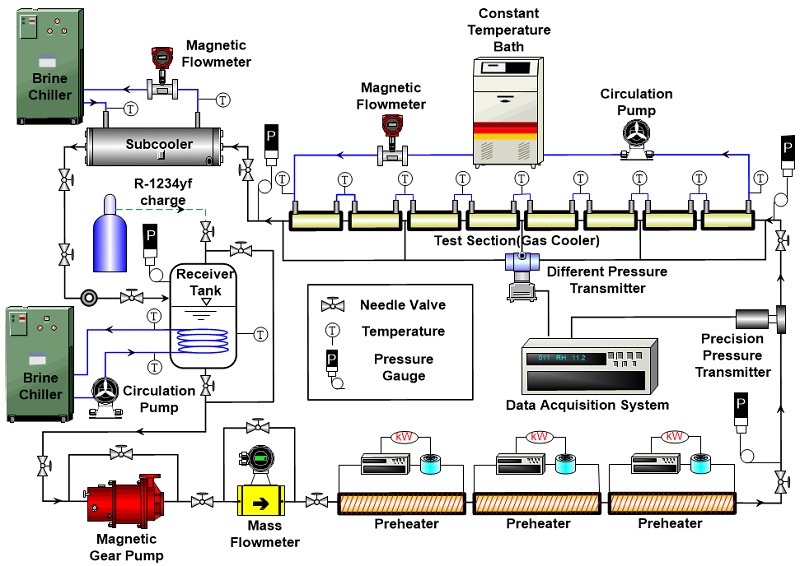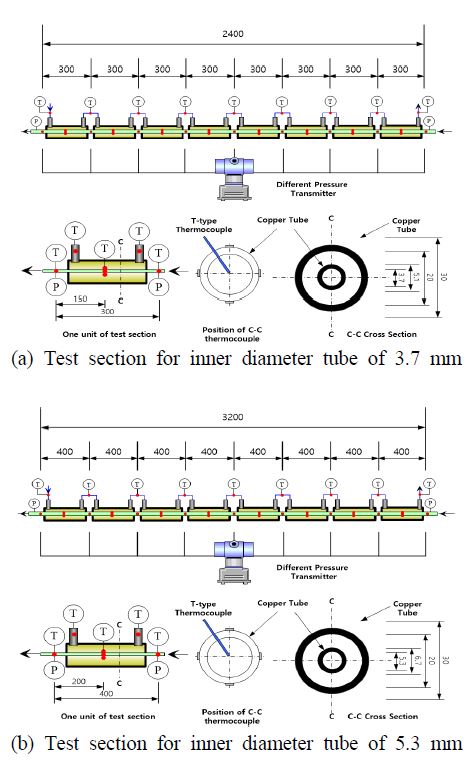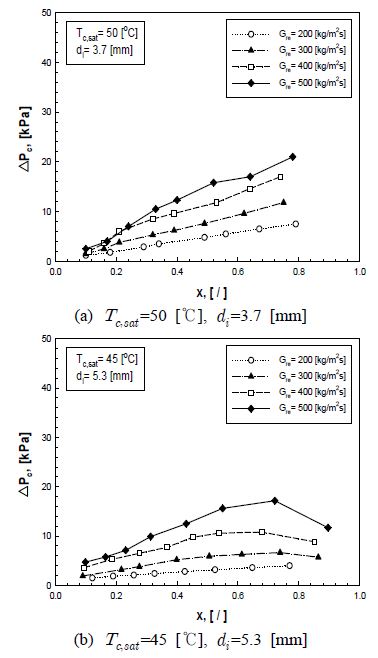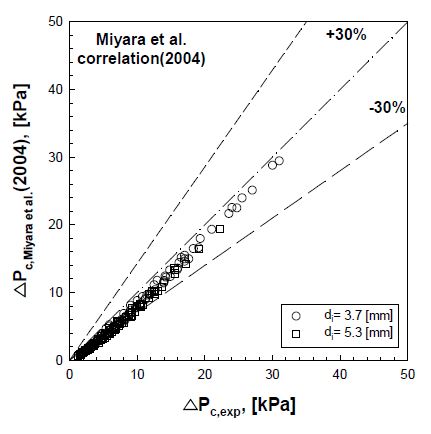
관경 변화에 따른 R-1234yf의 응축 압력강하에 관한 실험적 연구


Abstract
In this study, the condensation pressure drop of R-1234yf according to the variation of the tube diameter is experimentally studied and it is intended to be provided as the basic data for the design of the condenser. The experiment measured the pressure drop of R-1234yf by changing the mass flow rate, saturation temperature, and tube diameter. It also compared with the pressure drop of R-134a under the same conditions. As a result, the pressure drop tends to increase as the mass flow rate increases and the tube diameter decreases. In addition, the pressure drop tends to decrease as the saturation temperature increases. As a result of comparing the experimental results and the pressure drop of R-134a, R-134a showed a larger tendency than R-1234yf. As a result of comparing the experimental results with the existing correlation equation, the correlation equation of Miyara et al showed the most similar prediction.
Keywords:
Condensation, Pressure drop, R-1234yf, Variation, Pipe diameter1. 서 론
효율 및 안전성 측면에서 우수한 프레온계 냉매(CFC, HCFC)는 대기 중에 누출될 경우 오존층이 파괴되는 문제가 발생되어 2000년 이후 CFC계 냉매의 사용이 전면 금지되었으며, HCFC계 냉매 또한 2030년 이후로 사용이 전면 금지될 예정이다. 이러한 상황을 전환하고자 개발 중인 HFO계 냉매는 낮은 GWP를 가지고 있어 환경친화적인 신냉매로 주목받고 있다. HFC계 냉매 중 여러 분야에서 사용되고 있는 R-134a와 열역학적 물성치가 유사한 HFO계 냉매 R-1234yf에 대한 연구는 2006년 이후 활발히 진행되었으며1~6) 대표적인 종래연구는 다음과 같다.
Del col 등7)은 질량유속 200~1000 kg/m2s, 포화온도 40℃, 직경 0.96 mm 원형 미니채널 내 R-1234yf와 R-134a의 응축 압력강하를 실험적으로 연구하였다. 그 결과, R-1234yf의 압력강하는 R-134a보다 10~12% 낮다고 밝혔다. Illan-Gomez 등8)은 질량유속 350~940 kg/m2s, 포화온도 30~55℃, 내경 1.16 mm 미니채널 내 R-1234yf와 R-134a의 응축 압력강하 실험을 수행하였다. 그 결과, R-1234yf의 압력강하는 R-134a보다 5~7% 더 낮다고 보고하였다. Longo 등9)은 내경 4 mm 수평관 내 R-134a, R-152a, R-1234yf 및 R-1234ze(E)의 응축 압력강하에 대해서 비교 및 분석을 하였다. 그 결과, R-152a, R-1234yf 및 R-1234ze(E)는 R-134a와 유사한 압력강하 성능을 보여주므로 장기적으로 R-134a의 대체 냉매로 적절하다고 평가하였다.
위에서 언급한 종래의 연구들을 요약하면, 다양한 관경 변화에 따른 수평 평활관 내 R-1234yf의 응축기 내 압력강하에 대한 실험적 연구 결과가 대단히 부족한 실정이다. 따라서 R-1234yf의 응축 압력강하 메커니즘을 명확히 규명하기 위하여 실험적인 연구가 필요함을 알 수 있다. 본 연구에서는 R-1234yf를 작동 유체로 하여 관경 변화에 따른 응축 압력강하에 대한 실험적 연구를 하고자 하며, 냉동·공조 산업에서 중요한 요소인 응축기 설계를 위한 기초 자료를 제공하고자 한다.
2. 실험장치 및 데이터 정리
2.1 실험장치 및 조건
Fig. 1은 R-1234yf의 응축 과정 중에서 압력강하를 측정하고자 제작한 실험장치로 마그네틱 기어펌프, 예열기, 수액기 등으로 구성된 장치도이다. 장치도는 냉매 순환경로와 열원수 순환경로로 구분된다. Fig. 2는 시험부의 상세도를 나타낸 것이다. 냉매의 순환경로는 수액기에서 나온 냉매 액이 마그네틱 기어펌프를 통해 질량 유량계를 통과하며, 냉매 유량을 측정한다. 예열기에서 냉매 액은 가변 전압조정기로 인해 냉매 증기로 증발하며, 이때 일정 유량으로 조절하기 위해 유량 조절밸브와 바이패스를 사용한다. 냉매 증기는 시험부로 들어가서 열원수와 열교환하여 응축되며, 응축된 냉매 액은 수액기를 거쳐서 재순환한다. 열원수는 열원수 순환 펌프를 통해 순환하며, 냉동기 칠러로 온도를 일정하게 조절한다. 열원수의유량은 질량 유량계를 통해 측정한 후 일정 유량을 조절하며, 시험부의 외관과 내관 사이의 공간에서 냉매와 대향류로 흐른다. Table 1은 본 연구의 실험조건이다.
2.2 데이터 정리
수평관 내 응축 압력강하는 운동량에 의한 압력강하 ∆Pm, 마찰에 의한 압력강하 ∆Pf, 중력에 의한 압력강하 ∆Pg의 3가지 항의 합으로 식(1)과 같다.
| (1) |
여기서, 수평관 내를 유동하는 이상류의 압력강하는 중력의 성분을 무시하므로 ∆Pg=0이 되며, 식 (1)은 식 (2)와 같이 간단하게 정리된다.
| (2) |
압력강하 상관식들은 균질유동과 분리유동으로 가정하여 분석할 수 있다. 균질 유동모델은 열역학적 평형상태에서 기상과 액상의 속도가 동일하다고 가정한다. 대부분의 경우, 이러한 가정의 유동모델을 적용하기 곤란하지만, 이상류 압력강하를 예측하는데 있어서 좋은 일치를 보인다. 따라서 균질유동모델은 기상과 액상의 유동을 단상으로 취급하고 적절한 평균 물성치를 사용하여 운동량 압력강하를 아래의 식 (3)으로 나타낼 수 있다.
| (3) |
여기서, G는 액체와 기체의 총 질량유속이고, x는 증기건도이다. 본 연구에서 기공율 α는 균질유동 모델에 대해 정확한 예측이 가능한 수평관에서 Rouhani and Axelsson10) 드리프트 플럭스 모델의 Striner버전을 사용하였다.
3. 실험결과 및 고찰
3.1 질량유속의 영향
Fig. 3은 응축기 포화온도가 45, 50℃이고, 질량유속이 200~500 kg/m2s인 범위에서 측정한 냉매의 압력강하를 질량유속 변화에 따라 나타낸 것이다. 그림에서 알 수 있듯이, 모든 건도 영역에서 질량유속이 증가할수록 압력강하는 증가하는 것으로 나타났다. 이는 질량유속의 증가로 난류가 촉진되어 압력강하가 증가한 것으로 판단된다.
3.2 포화온도의 영향
Fig. 4는 R-1234yf의 국소 응축 압력강하를 포화온도 변화에 대해서 나타낸 것이다. 그림에서 포화온도가 증가하면 압력강하는 작아지는 것을 확인할 수 있다. 이는 Jung 등(1989)11)의 상관식으로 잘 설명할 수 있다.
| (4) |
| (5) |
| (6) |
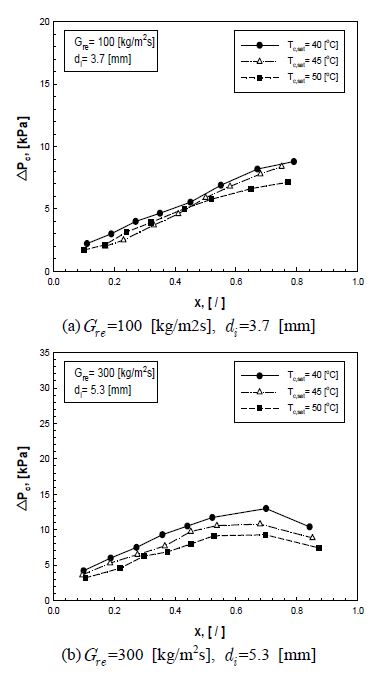
Variation of experimental pressure drop with different saturation temperature for constant mass and heat fluxes
식 (7)은 Martinelli and Nelson12)의 압력강하 상관식을 수정하여 제시된 Jung 등(1989)11)의 상관식이다. 이 식에서 이상류 압력강하는 마티넬리 변수와 밀접한 관계가 있다는 것을 확인할 수 있다. 식 (7)로 계산되는 Xtt는 기상과 액상의 밀도비(ρv/ρl)0.5, 액상과 기상의 점성계수비(μl/μυ)0.1 등 물성치의 영향을 고려한 변수로서, Jung 등(1989)11)의 응축 압력강하 상관식은 Xtt와 비례 관계에 있다. 따라서 냉매의 포화온도가 증가하면 Xtt값이 감소하여 응축 압력강하는 감소하게 된다.
| (7) |
3.3 관직경의 영향
응축기의 냉매관 직경은 압력강하에 상당한 영향을 미치므로, 관직경이 압력강하에 미치는 영향을 더 잘 이해하기 위해 관직경 변화에 따른 R-1234yf의 압력강하를 살펴보았다. Fig. 5는 일정한 포화온도와 질량유속 조건에서 R-1234yf의 압력강하를 관직경 변화에 대해 나타낸 것이다.
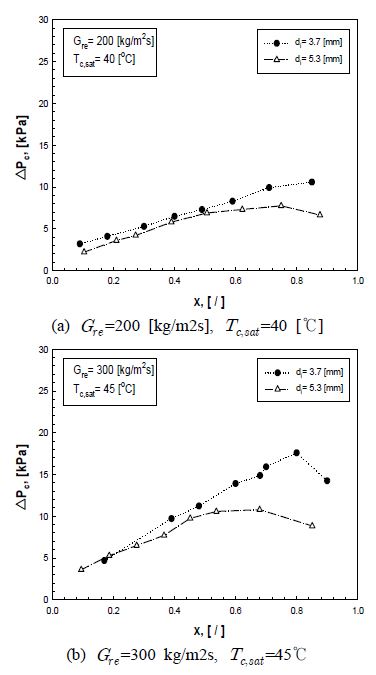
Variation of experimental pressure drop with different diameter tubes for constant heat flux and saturation temperature
Fig. 5의 결과로부터, 관직경이 감소할수록 압력강하는 증가하는 것을 알 수 있다. 이는 관직경이 감소할수록 전단 응력과 표면 장력의 영향이 증가하기 때문에 압력강하가 더 커지는 것으로 판단된다. 이에 대해서 Rahman 등13)과 Pabon 등14)은 동일한 연구 결과를 발표하였다.
또한 압력강하는 관직경이 감소할수록 또는 질량유속이 증가할수록 더욱더 두드러진다.
4. 압력강하 상관식
본 절에서는 지금까지 발표된 수평관 내 프레온계 냉매의 응축 압력강하 상관식인 Lockhart and Martinelli(1949),15) Miyara 등(2004),16) Hwand and Kim(2006),17) Li and Wu(2010)18)이 발표한 논문에서 제시한 R-1234yf의 응축 압력강하 상관식을 비교하여 그 적용 가능성을 확인하였다. 그 중 Miyara 등이 발표한 논문이 ±22% 이내의 오차 범위에서 좋은 일치를 보여 그대로 이용할 수 있었다.
Miyara 등은 내경 1∼4 mm, 질량유속 50∼400 kg/m2s 조건에서 공기-물, R-134a, R-410A의 작동유체를 사용하여 관직경과 질량유속을 고려한 압력강하 상관식을 제안하였다.
| (8) |
| (9) |
| (10) |
| (11) |
Fig. 6은 실험으로 측정한 압력강하와 Miyara 등의 상관식으로 계산한 압력강하를 질량유속 변화에 따라 비교한 것이며, Table 2는 상관식에 따른 평균오차와 절대 평균오차를 나타내었다. 그림에서 알 수 있듯이 실험으로 측정한 압력강하가 Miyara 등의 상관식과 유사한 값으로 나타났으며, 측정한 압력강하와 Miyara 등의 상관식으로 예측한 압력강하를 비교한 결과, 평균오차는 -21.7%이고, 절대 평균오차는 23.2% 정도였다. 이러한 결과는 Miyara 등의 상관식에 관경과 질량유속의 효과를 고려하여 포함시켰기 때문이다.
5. 결 론
본 장에서 관경 변화에 따른 R-1234yf의 응축 압력강하에 관한 실험적 연구에 대해서 실험한 결과, 다음과 같이 정리하였다.
1) 응축기 내 응축 과정 중에 R-1234yf 압력강하는 모든 건도 영역에서 질량유속이 증가할수록 압력강하는 증가하는 것으로 나타났다. 이는 질량유속의 증가에 따라 난류가 촉진되어 압력강하가 증가한 것으로 판단된다.
2) 기상과 액상의 밀도비와 점성계수의 영향으로 포화온도가 증가하면 압력강하는 작아지게 된다.
3) 관직경이 감소할수록 전단 응력과 표면 장력의 영향이 증가하기 때문에 압력강하가 더 커지게 된다.
4) R-134a와 R-1234yf의 압력강하를 비교한 결과, 대부분의 건도에서 R-134a의 마찰 압력강하가 R-1234yf보다 큰 것을 알 수 있다. 이는 두 냉매의 기상 밀도와, 액상과 기상의 점성계수 차이 때문이다. 종래의 압력강하 상관식과 비교한 결과, 내경 3.7과 5.3 mm의 수평 평활관 내 R-1234yf의 응축 압력강하는 Miyara 등의 관경 변화와 상관없이 가장 좋은 일치를 보였다.
5) 종래의 응축 압력강하 상관식 중 Miyara 등의 상관식으로 예측한 값과 실험값은 ±20% 이내의 오차 범위에서 좋은 일치를 보이므로 Miyara 등의 상관식을 그대로 이용하여 R-1234yf를 이용하는 응축기 설계에 이용할 수 있을 것으로 사료되나 추가적인 연구를 통해서 더욱더 정확한 상관식의 개발이 필요하다고 판단된다.
― 기 호 설 명 ―
| Bo : | 비등 수 |
| C : | 상수 방정식 |
| di : | 내경 [mm] |
| f : | 마찰계수 |
| Fr : | 프라우드 수 |
| G : | 질량 유속 [kg/m2s] |
| L : | 관 길이 [m] |
| n : | Miyara 상관식 상수 |
| P : | 압력 [MPa] |
| Re : | 레이놀즈수 |
| x : | 건도 |
| X : | 마티넬리 변수 |
그리스 문자
| ∆ : | 변화량 |
| α : | 보이드율 |
| μ : | 동점성계수 [Pa᛫s] |
| ρ : | 밀도 [kg/m3] |
| Φ : | 이상 승수 |
하첨자
| c : | 응축 |
| exp : | 실험 |
| f : | 마찰 |
| g : | 중력 |
| in : | 입구 |
| l : | 액체 |
| lo : | 총 액체흐름 |
| m : | 운동량 |
| out : | 입구 |
| re : | 냉매 |
| t : | 총합 |
| tp : | 이상상태 |
| v : | 기체 |
Acknowledgments
본 연구는 2021년도 정부(과학기술정보통신부)의 재원으로 한국연구재단의 지원을 받아 수행된 연구임(NO.2019R1F1A1059974).
References
-
C. H. Son, J. H. Lee, J. I. Yoon, S. H. Seol, S. Y. Cha and N. W. Kim, 2021, "Experimental study of evaporation heat transfer of R-1234yf in 7 mm horizontal smooth tube", Journal of Power System Engineering, Vol. 25, No. 2, pp. 74-79.
[https://doi.org/10.9726/kspse.2021.25.2.074]

- C. H. Son, 2004, "Heat Transfer Characteristics of Supercritical Cycle of Carbon Dioxide in a Horizontal Tube", Ph. D thesis, Pukyong National University, Pusan, Korea.
- D. G. Lee, 2006, "Heat transfer characteristics of carbon dioxide in an evaporator and gas cooler", MS thesis, Pukyong National University, Pusan, Korea.
- S. W. Lee, 2021, "Condensation Heat Transfer and Pressure Drop of HFO-1234yf in 4 mm Horizontal Tube", MS thesis, Pukyong National University, Pusan, Korea.
-
D. A. Didion and D. B. Bivens, 1990, "Role of Refrigerant Mixtures as Alternatives to CFCs", International Journal of Refrigeration, Vol. 13, No. 3, pp. 163-175.
[https://doi.org/10.1016/0140-7007(90)90071-4]

-
C. H. Son, J. H. Lee, J. I. Yoon, S. H. Seol, E. M. Park and S. W. Lee, 2021, "Condensation heat transfer of R-1234yf in horizontal tube", The Korean Society For Power System Engineering Vol. 25, No. 2, pp. 80-85. (DOI : 10.9726/kspse.2021.25.2.080)
[https://doi.org/10.9726/kspse.2021.25.2.080]

-
D. Del Col, D. Torresin and A. Cavallini, 2010, "Heat transfer and pressure drop during condensation of the low GWP refrigerant HFO1234yf", International Journal of Refrigeration, Vol. 33, No. 7, pp. 1307-1318.
[https://doi.org/10.1016/j.ijrefrig.2010.07.020]

-
F. Illan-Gomez, A. Lopez-Belchı, J. R. Garcıa-Cascales and F. Vera-Garcıa, 2015, "Experimental two-phase heat transfer coefficient and frictional pressure drop inside mini-channels during condensation with R1234yf and R134a", International Journal of Refrigeration, Vol. 51, pp. 12-23.
[https://doi.org/10.1016/j.ijrefrig.2014.11.014]

-
G. A. Longo, S. Mancin, G. Righetti and C. Zilio, 2019, "Saturated vapour condensation of R134a inside a 4 mm ID horizontal smooth tube: Comparison with the low GWP substitutes R152a, R1234yf and R1234ze(E)", International Journal of Heat and Mass Transfer, Vol. 133, pp. 461-473.
[https://doi.org/10.1016/j.ijheatmasstransfer.2018.12.115]

-
Z. Rouhani and E. Axelsson, 1970, "Calculation of void volume fraction in the subcooled and quality boiling regions", International Journal of Heat Mass Transfer, Vol. 13, No. 2, pp. 383-393.
[https://doi.org/10.1016/0017-9310(70)90114-6]

-
D. S. Jung, M. McLinden, R. Radermacher and D. Didion, 1989, "A study of flow boiling heat transfer with refrigerant mixtures", International Journal of Heat and Mass Transfer, Vol. 32, No. 9, pp. 1751-1764.
[https://doi.org/10.1016/0017-9310(89)90057-4]

- R. C. Martinelli and D. B. Nelson, 1948, "Prediction of pressure drop during forced-circulation boiling of water", Trans. ASME, Vol. 70, No, 7, pp. 695-702.
-
M. M. Rahman, K. Kariya and A. Miyara, 2017, "Experimental investigation of condensation heat transfer and adiabatic pressure drop characteristics inside a microfin and smooth tube", International Journal of Air-Conditioning and Refrigeration, Vol. 25, No. 3, pp. 1-11.
[https://doi.org/10.1142/S2010132517500274]

-
J. G. Pabon, A. Khosravi, R. Nunes and L. Machado, 2019, "Experimental investigation of pressure drop during two-phase flow of R1234yf in smooth horizontal tubes with internal diameters of 3.2 mm to 8.0 mm", International Journal of Refrigeration, Vol. 104, pp. 426-436.
[https://doi.org/10.1016/j.ijrefrig.2019.05.019]

- R. W. Lockhart and R. C. Martinelli, 1949, "Proposed correlation of data for isothermal two-phase, two-component flow in pipes", Chemical Engineering Process, Vol. 45, No. 1, pp. 39-48.
-
A. Miyara, K. Kuwahara and S. Koyama, 2004, "Correlation of frictional pressure loss of two-phase flow including effects of tube diameter and mass velocity", The Japan Society of Mechanical Engineers, Kyushu branch of the speech collected papers, No. 048-1, pp. 117-118.
[https://doi.org/10.1299/jsmekyushu.2004.57.117]

-
Y. W. Hwang and M. S. Kim, 2006, "The pressure drop in microtubes and the correlation development", International Journal of Heat and Mass Transfer, Vol. 49, No. 11-12, pp. 1804-1812.
[https://doi.org/10.1016/j.ijheatmasstransfer.2005.10.040]

-
W. Li and Z. Wu, 2010, "A general correlation for adiabatic two-phase pressure drop in micro/mini-channels", International Journal of Heat and Mass Transfer, Vol. 53, No. 13-14, pp. 2732-2739.
[https://doi.org/10.1016/j.ijheatmasstransfer.2010.02.029]

